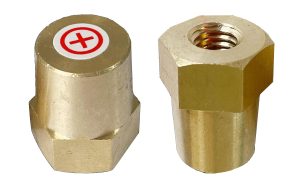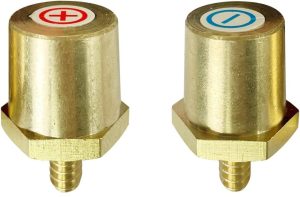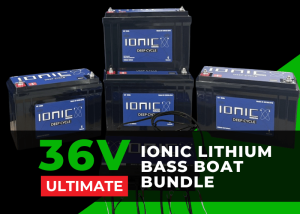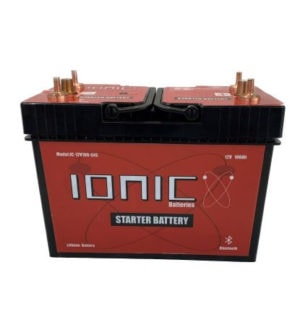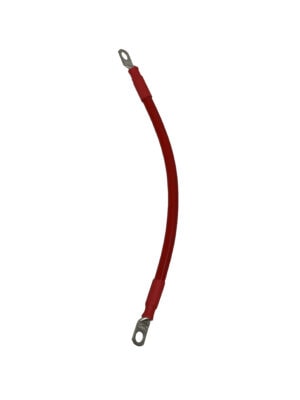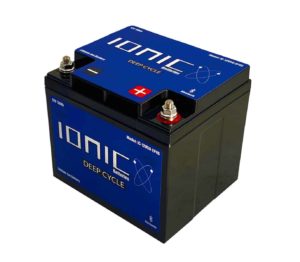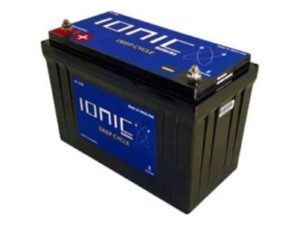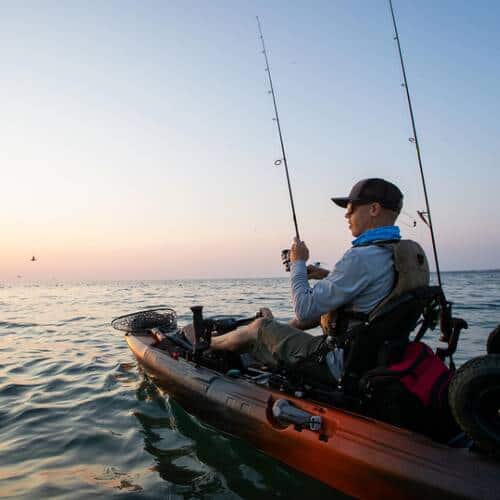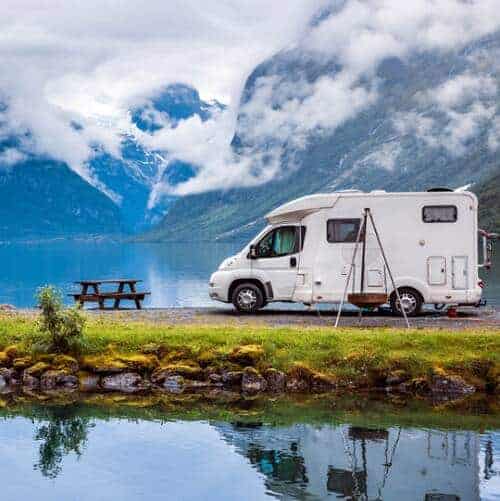Why is charging RV batteries correctly so important? For starters, who wants to be stuck without power when they need it most? Like in hot, sticky weather, close to a beach but far from campgrounds. Second, careful charging extends the life of your battery. Charging RV batteries the right way ensures they’ll last for countless rounds of camping and boondocking!
The instructions below are for 12V deep cycle RV house batteries. (Or an equivalent, such as 6V batteries wired together).
When to Charge Your RV House Batteries
You have to charge most battery types after they’ve been discharged to 50%. If you wait until the battery is discharged past that mark, you may damage it. Waiting until it’s completely discharged can cut a battery’s life short and reduce efficiency.
The one exception is lithium batteries. You can discharge LiFePO4 RV house batteries completely with no ill effects. But we recommend charging them when they reach about 80% depletion. This can maximize their life span and performance.
4 Methods for Charging RV Batteries
There are four ways to charge RV house batteries:
- Shore power
- Generator
- Vehicle alternator
- Solar panels
All of the above are safe, effective ways to charge. But some are faster than others. Choose the right method for your needs. You might want to read up on how to charge via all four methods, since each one is useful for different circumstances.
Shore Power
By “shore”, we mean regular-old grid power. Many campgrounds have power pedestals where you can juice up. They often dispense 30 or 50 amps, which is double or more than what you get at home. That means you can charge your RV battery fast, and also run some appliances while charging.
Shore Power with Power Cable and Converter
But plugging into shore power isn’t as simple as just plugging a cable in. The electricity will have a voltage of either 240 or 120. That’s not compatible with a 12 volt battery. Also, shore power is alternating current (AC), while batteries use direct current (DC). So you’ll need a power converter. Then you can plug your RV’s power cable into a 120V AC electrical outlet at the campground.
Shore Power with Battery Charger
A second way to charge via shore power is using a battery charger. But this method won’t allow you to use your appliances at the same time. You’ll have to turn them off so they don’t divert current away from your battery. Be sure to use a charger that suits your battery type (lead acid, AGM, gel, lithium).
Generator
You can also charge your RV house batteries with a generator. Generators are reliable, but they’re cumbersome and noisy. That can defeat the purpose of getting away from the hustle and bustle of the city. But generators can come through in a pinch, and some RVs already include them. To use it, plug your RV’s power cable. Follow the included instructions and be sure to bring along extra fuel.
Vehicle Alternator
Some RVs allow you to charge your RV house batteries while the engine of your towing vehicle is running. The alternator makes this possible by converting mechanical energy into storable battery energy. Sounds convenient? It is if you’ll be spending a lot of time on the road. But it’s by far the slowest method for charging RV batteries. So make sure you have another plan for charging your batteries while parked.
Solar Panels
Looking for the cleanest, greenest method for charging RV batteries? Set your eyes on the sun (but not literally!) You can harness the sun’s power and convert it to storable battery power with a solar setup. You’ll need solar panels, a charge controller, and a DC/AC Inverter for your AC appliances.
Solar charging allows you to stray far from campgrounds. It can keep your energy costs at a minimum, as well as your carbon footprint. The one disadvantage? You’re at Mother Nature’s mercy. If your power draw is larger than your reserve, you might find yourself without power on cloudy days.
Steps for Charging RV Batteries
These are general instructions for all types of RV house batteries. Be sure to follow any additional guidelines that come with your batteries.
- Find a level place to park your RV. Park it and put on the parking brake.
- Shut off the engine. Turn off any appliances you’re running.
- Remove the cables from the battery leads with a wrench. Disconnect the negative cable first (black). Then remove the positive cable (red).
- If you have a lead acid battery, check for sulfation. Clean it with a baking soda and water solution. Add distilled water if required.
- Check for dirt and dust and clean if necessary. (All battery types).
- Connect the cables of your converter or battery charger to the battery. (Positive first, then negative).
- Plug your charger (or converter) into your power source. Turn on if necessary.
- If you have a lead acid battery, wait for the indicator light on your converter or charger to turn on. This means your battery is fully charged. You’ll need to stick around to avoid overcharging your battery. Then disconnect it, following the steps above in reverse order.
- If you have a lithium battery, go ahead and grab a sandwich or run some errands. We mean it! No battery babysitting needed. As long as you’re using a lithium charger, your battery won’t overcharge. If you want to know how much longer it’s going to take to charge, take a peep on the Bluetooth app (included with LithiumHub batteries).
- For charging batteries in series or parallel, check out the instructions on this page.
How to Charge RV Batteries Safely
Following best practices when charging RV batteries ensures you don’t harm yourself or your batteries. While the safest battery type is Ionic lithium, you should handle every battery type with care.
Safe Charging Tips
- Store and install your batteries in a clean, cool, and dry place.
- Wear safety gear when working with RV batteries that contain lead acid. There are no acids or liquids in LiFePO4 (lithium) RV batteries.
- Avoid undercharging lead acid batteries. You should not discharge them past 50%. This problem doesn’t affect lithium batteries. But you’ll get optimum performance out of them if you avoid discharging past 80%.
- Don’t overcharge lead acid RV batteries. This causes electrolysis of the water inside the batteries. Flammable gasses can escape, and explosions are possible. Overcharging will reduce your battery’s lifetime. Banish overcharging worries completely by opting for lithium batteries.
Charging in Cold Weather
Avoid temperature extremes when charging RV batteries. Don’t charge your RV batteries if temperatures are below 0°C (32°F). This can cause permanent damage. However, you can still use lithium RV batteries below freezing temperatures. They will have a bit less capacity. They will also warm up much quicker than lead acid batteries. Got your heart set on camping in the wild, snowy north? We recommend using lithium RV batteries with a built-in heater.
Shop Lithium Batteries with Built-in Heater: 12V 125Ah and 12V 300Ah
Charging in Hot Weather
Hot temperatures speed up chemical reactions inside lead acid type batteries. Avoid charging your lead acid RV batteries above 86°F (29°C). Let them reach room temperature first.
The recommended operating temperature range for lithium batteries is between -4°F to 122°F (-20°C to +50°C) with a humidity of <90%. Don’t charge your lithium RV battery if temperatures climb above 122°F (50°C).
HAVE QUESTIONS ABOUT CHARGING RV BATTERIES? CONTACT OUR EXPERTS HERE
Recent Reviews
shop lithiumhub products
our best selling ionic brand lithium batteries
Our Ionic lithium marine batteries are created with the highest quality materials. Built for the long haul, these batteries will provide you with countless hours of enjoyment on the water.
-
Ionic Lithium 12V 50Ah | LiFePO4 Deep Cycle Battery + Bluetooth
Original price was: $599.00.$349.00Current price is: $349.00. Add to cart -
Ionic Lithium 12V 100Ah | LiFePO4 Deep Cycle Battery + Bluetooth
Original price was: $1,099.00.$699.00Current price is: $699.00. Add to cart -
Ionic Lithium 12V 125Ah | Dual Purpose Starter Battery 1100 CA + LiFePO4 Deep Cycle
Original price was: $1,199.00.$789.00Current price is: $789.00. Add to cart

need help finding the right deep cycle battery?
Our experts are just a click (or a call) away. Get fast, expert battery advice from a real human, located right here in the USA.
revolutionize every adventure
Ready to revamp your boat, RV, kayak, or solar setup? Select your pastime to get started.
Maximize Your Machine’s Potential
Ionic Lithium LiFePO4 batteries aren’t just for play. Put them to work in your commercial applications, scooter, UTV, or lawnmower setups. Shop batteries by application below.
GET IN THE LOOP
We’re always adding incredible lithium products to our lineup. Want to be the first to know when they drop? Sign up for LithiumHub updates, and get the inside scoop on exclusive deals and exciting new additions.

